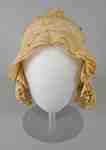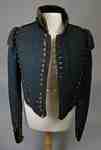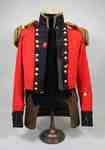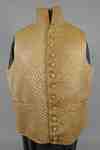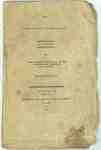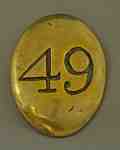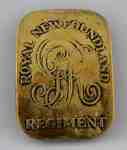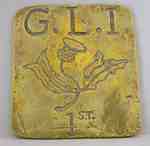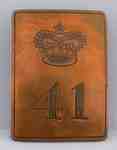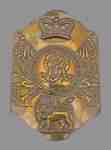Résultats
- A day bonnet made of very fine cotton lawn fabric with handworked cotton lace edging and inserts. There are also bands around the cap where the material is gathered in between and lace trim and insetA day bonnet made of very fine cotton lawn fabric with handworked …
- These breeches belonged to George Ball who was born in Schoharie, N.Y. in 1765, and moved to Upper Canada as a United Empire Loyalist. He served in the War of 1812, was a partner in the establishmentThese breeches belonged to George Ball who was born in Schoharie, N.Y. …
- This is a wool and velvet coatee that is believed to be designed for a Glengarry Militia Officer, but the date of origin is unknown. It is a single breasted green coat with a velvet trimmed stand upThis is a wool and velvet coatee that is believed to be …
- This uniform coat was worn by Captain MacMicking of the Lincoln Militia, 1st Regiment. The double breasted coat is red brushed wool broadcloth with black lace on the dark blue wool lapels, collar andThis uniform coat was worn by Captain MacMicking of the Lincoln Militia, …
- This uniform coat belonged to Colonel Aeneas Shaw of the 1st Regiment of the Lincoln Militia during the War of 1812. It is believed to be a staff officer uniform and has five pairs of buttons down thThis uniform coat belonged to Colonel Aeneas Shaw of the 1st Regiment …
- This single gloves was fashioned from white tulle and carefully embroidered. It is in the long sleeve style and shows what women of 1812 would have worn.This single gloves was fashioned from white tulle and carefully embroidered. It …
- This silk bodice was likely part of an evening dress and may have had a matching skirt. The fabric is from an earlier time period and was most likely remade from an 18th century dress. The bodice feaThis silk bodice was likely part of an evening dress and may …
- This uniform coatee was worn by Colonel Daniel McDougal when he was an Ensign at the Battle of Lundy’s Lane on July 25, 1814. The design is for a Junior officer (ensign or lieutenant) of the VolunteeThis uniform coatee was worn by Colonel Daniel McDougal when he was …
- This scarf was fashioned out of silk and wool and features a green and rose floral pattern on a cream background and a tassle fringe around the edges. The scarf is thought to have belonged to Mrs. SeThis scarf was fashioned out of silk and wool and features a …
- Part of the Servos Collection, and is listed as a British Officer’s waistcoat once belonging to Alonzo Strong of St. Ann's Ontario. It is more likely that it is a domestic waistcoat. There are elevenPart of the Servos Collection, and is listed as a British Officer’s …
- Reprint of "The Christian Confession of the Faith of the Harmless Christians, in the Netherlands Known by the Name of the Mennonists" Niagara [Ont.] : Amsterdam, printed. Re-printed and sold by JosepReprint of "The Christian Confession of the Faith of the Harmless Christians, …
- This scrapbook contains various newspaper articles relating to Niagara and other distant points of interest. It is unsure exactly what newspapers are included. However, it seems that most articles orThis scrapbook contains various newspaper articles relating to Niagara and other distant …
- This brass cross belt plate is oval shaped and stamped with a "49". This number symbolizes the 49th Regiment of Foot, the Royal Hertfordshires. The 49th Regiment is perhaps the most well known of thoThis brass cross belt plate is oval shaped and stamped with a …
- This is an oblong, convex brass plate for a soldier’s cross belt from 1803-1812. It is stamped with the cipher “GR” and “Royal Newfoundland Regiment”. This regiment served in Niagara during the War oThis is an oblong, convex brass plate for a soldier’s cross belt …
- This rectangular bass plate is stamped with a crown and “GR” cipher with an inscription: “MAIDA” (above crown) and “Reg. de. Watteville” (below cipher). This item is from a cross belt of a uniform ofThis rectangular bass plate is stamped with a crown and “GR” cipher …
- This an eighteenth century officer’s woven silk maroon sash with tassels on the ends.This an eighteenth century officer’s woven silk maroon sash with tassels on …
- This brass cross belt plate was fashioned to represent the Glengarry Light Infantry Fencibles. The rectangular plate is stamped with the initials “GLI” and the number one for 1st Battalion. There isThis brass cross belt plate was fashioned to represent the Glengarry Light …
- This brass cross belt plate is stamped "41" and a crown which was created to represent the Forty-first Regiment of Foot, also known as the Welsh Regiment.The first battalion came to Canada from IrelaThis brass cross belt plate is stamped "41" and a crown which …
- This plume with black feathers and a wooden base would have been placed on a soldier’s shako. It is believed to have belonged to Captain Martin McLellan who took part in the battle of Queenston HeighThis plume with black feathers and a wooden base would have been …
- This is a regulation issue plate for a stove pipe shako that was supplied to infantry regulars between 1803 and 1812. There is a Hanoverian crown on the crest with a “GR” cipher surrounded by a GarteThis is a regulation issue plate for a stove pipe shako that …





